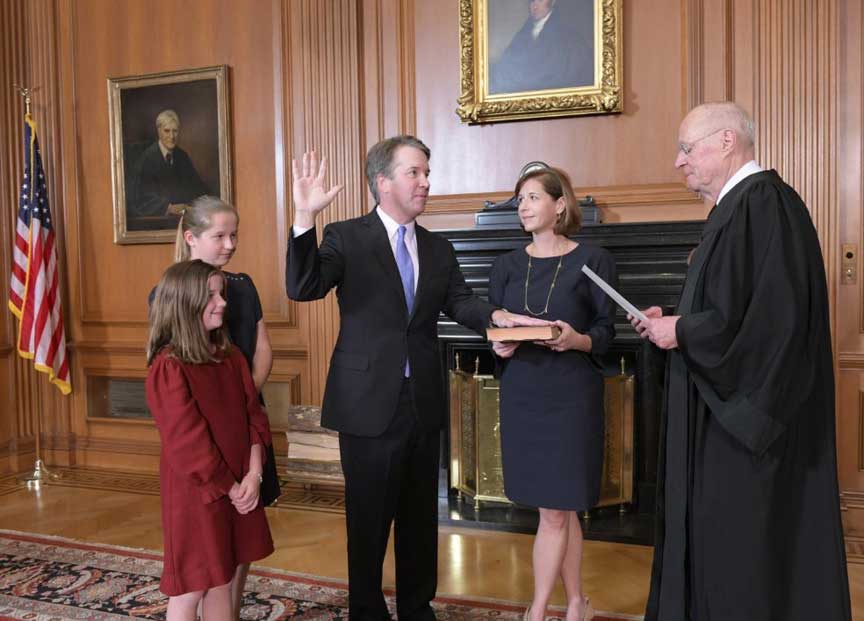Kavanaugh Confirmed to Supreme Court

The US Senate confirmed President Trumps nomination of Brett ot the Supreme Court on October 6th, 2018. Kavanaugh replaces Justice Kennedy who retired in June and was considered the swing vote on the court. Kavanaugh’s judicial record is more conservative than that of Kennedy.
The US Senate by a vote of 50 to 48 confirmed the nomination of Brett Kavanaugh to Supreme Court. The vote came after the most contentious confirmation debate in recent American history. Kavanaugh was nominated after Associate Justice Anthony Kennedy of Savannah had clerked for retired in June. Kennedy was considered the swing vote on the court voting conservative on most issues but taking a more liberal position on topics such as gay rights. Kavanaugh who had been a Yale undergraduate and law school graduate after clerking for Justice Kennedy worked for four years as a lawyer in the Bush White House before being nominated for the US District where he served as a judge for 16 years.
Kavanaugh was on the original lists of judges that President Trump had put forth when he ran and is a member of the Federalist Society. When his name was announced, the pick was strongly opposed by the Democrats. An early issue in the confirmation hearings where tens of thousands of documents from the period that Kavanaugh served in the Bush White House that were not provided to the Senate Judiciary Committee that reviewed the nomination. However, the minorities ability to delay or stop a nomination had been all but destroyed by both Republicans and Democrats who had eliminated the rules that allowed for a filibuster in the nominating process.
It looked that despite the unified Democratic opposition Kavanaugh was going to be confirmed without too much difficulty. However, a Professor of Psychology at Palo Alto College Dr. Christine Blassey Ford came reported that when both she and Kavanaugh was in College Kavanaugh had attempted to rape her. A number of additional women came forward and claimed that Kavanaugh had not acted appropriately After a few days of discussion the Republican Chairman of the Judiciary Committee agreed to reopen the hearing and hear from both Dr. Ford and Justice Kavanaugh about the charges. The Republican on the Committee decided to hire an outside woman counsel to ask Dr. Ford questions. The hearing was held on September 27th. She gave compelling testimony that convinced many that she was telling the truth. At the end of her testimony even right-wing media sources said Kavanaugh was done. However, after Ford’s testimony Kavanaugh testified and gave an angry partisan speech claiming that the attacks on him were part of a partisan witch hunt. Kavanaugh speech seemed to galvanize the Republican on the committee who started speaking in support of Kavanaugh. The next day there was an expectation that the committee would vote to approve the nomination and send to the Senate. At the last moment, Senator Flak stated that he would vote in favor of sending it to the Senate but only on the condition that the FBI would do an additional background check on Kavanaugh. The White House agreed and a limited FBI investigation which interviewed nine witnesses. The results of the investigation which were not shared with the public and secretly shared with the Senators did not bring to light any new corroborating evidence of Dr. Ford's allegations. The Democrats and Ford’s lawyers complained bitterly that a full investigation of Judge Kavanaugh had not been done. Many questions remained unanswered including issues of whether the Judge had been wholly truthful during his testimony. The critical Republican Senator whose views were unknown until the end were Susan Collins of Maine and Senator Lisa Murkowski of Alaska and retiring Senator Flake of Arizona. In the final vote, Murkowski was the only Republican who opposed the nominee. The final vote was 50-48 with one Democrat voting in Kavanuah’s favor. It was the closest vote since 1881 when a vote of 24 to 23 confirmed justice Stanley Matthews.
